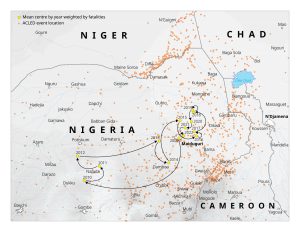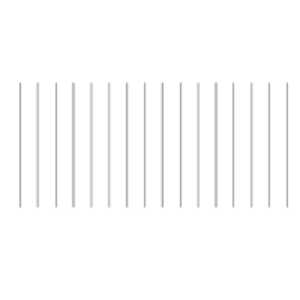by Lacey Harris-Coble, University of Florida
3 August 2023
The centre of gravity of the Boko Haram insurgency has returned to Maiduguri, after having migrated from west to east for almost 15 years across the Lake Chad region. This evolution illustrates the mobility of jihadist groups in the region and the need to better understand the spatial life cycle of conflict.
Maiduguri is by far the most violent city in West Africa. More than 4 547 people have been killed in this large regional hub since Boko Haram launched a massive insurgency against the Nigerian government in 2009. Since then, the insurgency has spread to most regions of north-east Nigeria, where security forces fight an asymmetrical conflict that shows no sign of abating. In 2023, violence by Boko Haram and its splinter group, the Islamic State West Africa Province (ISWAP), is concentrated in Borno, Yobe and Adamawa states, where 94% of violent events and 80% of fatalities in Nigeria were recorded between 2009 and 2022. The insurgency has also affected neighbouring Cameroon, Chad and Niger, where remote islands on Lake Chad and mountainous regions provide a safe haven for the insurgents.
One way to visualise the shifts in the geographic distribution of this insurgency is by mapping changes in the mean centre of violent events by year. The mean centre measures the geographic centre of a group of projected points; in this case, the geographic centre of the locations of all violent events recorded by the Armed Conflict Location & Event Data Project (ACLED) for each year from 2009 to 2022. This location is not necessarily the most violent place, simply the most central one. We consider three types of politically motivated events in which Boko Haram and ISWAP were involved as perpetrators or victims: battles, violence against civilians, and remote violence such as suicide attacks. Each event is weighted by the number of fatalities, in order to give more importance to the most lethal locations.
Our analysis of 7 570 violent events shows that although north-eastern Nigeria has been the focal point of the conflict, the distribution of events and fatalities within that area has shifted over time (Map 1). Until the early 2010s, the centre of gravity was centred on Maiduguri, reflecting the initial location of intense conflict between Boko Haram and the Nigerian government. With the diffusion of the conflict to neighbouring Nigerian states, the mean centre moved away from Maiduguri and reached its westernmost point in 2012 near the city of Potiskum.
Between 2012 and 2018, the mean centre for violent events shifted east towards the border with Cameroon and Chad. This shift reflects the internationalisation of the conflict and the growing importance of border regions for the insurgents. Since 2018, the mean centre of violent events has shifted westward closer to the city of Maiduguri, just a few kilometres from where it was in 2009.
Mapping the shifting patterns of the entire insurgency is, of course, a simplification of reality. Boko Haram and ISWAP have, since 2016, operated as independent (and rival) factions and the insurgency is now fragmented into numerous autonomous cells. To reflect the fragmentation of violence across the region, each major faction should be monitored separately. However, mapping the centre of gravity of the Boko Haram insurgency as a whole can help better understand shifting patterns of violence in the region and the continuing importance of certain strategic towns, such as Maiduguri, for the insurgents.


